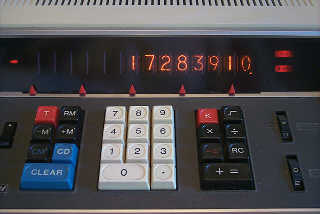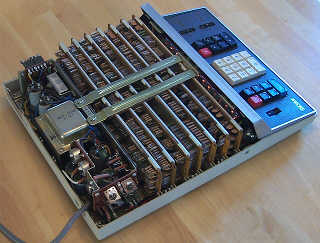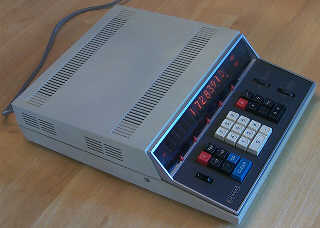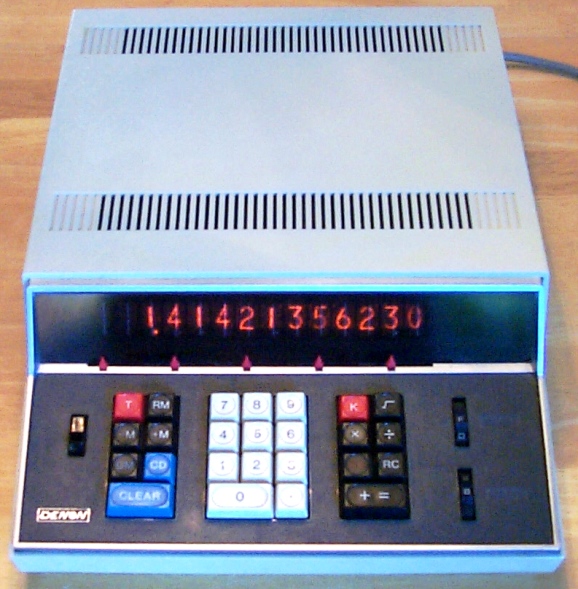

| +Home | Museum | Wanted | Specs | Previous | Next |
Denon DEC-61A4 Electronic Calculator
Updated 12/31/2017
I have a particular affection for Denon electronic calculators, though, sadly, they are now forgotten relics in the history of electronic calculators.
Many years ago (perhaps 1969 or 1970), a neighbor-kid's father worked for an accounting firm. One day back then, my neighborhood friend came over to my house saying that his Dad had brought home a cool machine that could do math and had "tubes". I had an idea what he might be talking about - an electronic caculator. With urgency, we ran back to his house to find out what amazing device might be found. His house was only two houses down the street, so it took just seconds to get there. There on the dining room table was a Denon Nixie tube display calculator (I don't remember the model number, but the machine was very similar to the calculator exhibited here). My friend's father had just been assigned this calculator to be used for taking work home with him (a somewhat sad precedent set by the advent of portable computing devices). His Dad was rather concerned about us playing with the machine, for fear of us "breaking" it, but he did let us play with it for a while under close supervision. I swear this kid's Dad nearly had a heart attack when I commanded the machine to divide by zero, which caused the display to go blank with no response to the keyboard. He felt much better when I pressed [CLEAR] and the machine returned to normal. At that point though, he'd had enough, and told us play-time was over. Years later, when a machine like the one I played with became available, I was quite happy to be able to add it to the museum, both from the point of view that the exhibited calculator is the first electronic calculator marketed by Denon, and also simply from the memories a machine like it made in my younger days.
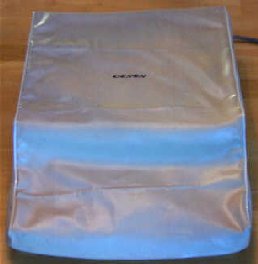
Protective Dust Cover
The Denon brand is known today for quality audiophile equipment. The respected brand name for Tokyo-based Nippon Columbia Co., Ltd., has been around since 1910 as a manufacturer of phonographs (record players), and as with many electronics-oriented companies, Denon had a brief foray into the electronic calculator business beginning in the fall of 1968 through sometime in 1972 when it exited the highly competitive market.
The DEC-61A4 was Denon's first entry into the calculator market, introduced in September of 1968. Interestingly, Denon produced a machine with identical electronics called the DEC-621, with the only difference being that the square root key was omitted from the keyboard, and the keys are slightly re-organized. The DEC-621 provided an additional market for Denon, but at a reduced cost due to the lack of the square root function. In fact, a DEC-621 exists that has the same model number tag as the 61A4, with the 61A4 model number partially obscured by a black marker, and "DEC 621" stamped below it. Denon made a number of other calculators after the DEC-61A4 and DEC-621, including the DEC-521, DEC-512, DEC-421, DEC-412, DEC-411, and the unusual (integer-only, no divide function) DEC-311.

Denon 61A4 with Top Cover Removed
Nippon Columbia first marketed this calculator in Japan as the Columbia COLCA (COLumbia CAlculator) 61A. Not long after its introduction in Japan, Denon, the US marketing arm of Nippon Columbia, introduced the machine to the North American market as the Denon 61A4. This calculator was built at a time when integrated circuits were just starting to become available for use in anything but military equipment, space applications, or large-scale computers. The cost of integrated circuits was still quite high in comparison to discrete component logic. However, the integration of a number of logic gates, or a few flip flops into a single small package made it possible to make the machines smaller, a real consideration when desktop space always seems to be a limited commodity. So, as IC technology became available, calculator manufacturers started to integrate (excuse the pun) the technology into their designs. The 61A4 is a hybrid machine, using some integrated circuit logic elements, and some discrete component logic. This machine sits pretty much in the middle of the range of hybrid machines at the time, with an example of the low-integration hybrid calculator being the Burroughs C3350; and a high-integration example being the Brother Calther 412.

A Closer View of the Circuit Boards
The majority of the logic of the DEC-61A4 is contained on a total of seven plug-in circuit boards. The boards plug into a backplane board located across the bottom of the chassis. Each board is approximately 11x3 inches, and packed at quite a high density with components. The boards use a lot of diode-resistor gate elements, with the gates built up vertically, with a common bus-bar across the top ends of the components. Each board has a plastic shield on the back side of the circuit board to prevent components on the board behind from shorting to adjacent circuit boards.


Two of the DEC 61A4 Circuit Boards
The circuit boards are made of phenolic, and
have traces on both sides of the board, with plated-thru holes for
interconnections between the sides of the board. The sprinkling of
integrated circuits in the machine are all DIP
(Dual-inline Package)-style plastic-packaged
devices made by Mitsubishi. Most of the ICs are of the M53xx/M59xx-family,
which are small scale bipolar devices, of DTL (Diode-Transistor Logic)
construction. Each circuit board plugs into the backplane via two
edge connectors.
Keyboard/Display Detail
The 61A4 uses fourteen Nixie tubes
for its display, mounted on a separate circuit board that connects via
jumper wires to the main board (backplane) of the machine. Each Nixie
tube has the digits zero through nine and a right-hand decimal point.
The calculator provides leading zero suppression.
During calculations, the displays are blanked,
making the machine less entertaining than other machines which leave
the displays active during calculation. A neon lamp situated at the left
end of the display panel lights through a minus-shaped cutout to indicate
negative numbers. This indicator flickers when the machine is
calculating square roots. Other calculations do not seem to effect
the '-' indicator in this way, which could indicate that the behavior
is simply an artifact of the way that the square root operation is carried out.
Two neon indicators at the right end of the display indicate the status of
the memory register, and an error(overflow) condition.
Another Internal View
The 61A4 operates quite conventionally,
with arithmetic logic. There are some inconsistencies in the way the
machine operates, which I've not yet quite figured out. Unfortunately,
at this time, the museum does not have possession of an operator's manual
for the machine, so some aspects of the machine's operation are inferred
by simply tinkering around with the machine. Operation of the
constant function (engaged by a push-on/push-off red pushbutton marked
[K]) seems rather unique. The [RC] key swaps operands for multiplication
and division operations. The memory function also operates quite
conventionally, with separate keys for adding and subtracting the
content of the display from the memory register. The memory register
can also be used for sum of products operations through the red [T]
key on the keyboard. This push-on/push-off key, when activated, automatically
causes the results of multiplication or division operations to accumulate
in the memory register. When the [T] key is de-activated, the content
of the memory register is automatically recalled to the display. The
memory register may be cleared independently of the rest of the calculator
via a [CM] key, and the content of the memory register can be recalled to
the display with a press of the [RM] key. An indicator on the right end
of the display panel lights up (via a Neon lamp) "MEMORY" to indicate non-zero
content of the memory register. The [CD] key clears the display in case of
entry errors, and the [CLEAR] key clears the entire machine except for the
memory register. The [CLEAR] key also clears any error condition. Error
(actually, overflow) conditions result in the ERROR indicator lighting up
at the right end of the display panel. The error indication does not cause the
keyboard to lock or otherwise inhibit further operation of the machine.
Pressing ANY key when the ERROR indicator is lit immediately extinguishes
the indication. The notation ERROR for this indicator is a bit of a
misnomer, as the indicator truly only indicates an overflow condition.
Overflows of the machine cause the error indicator to turn on, and any
overflow digits to be discarded. Because the overflow (ERROR)
indicator is cleared by pressing any key, the overflow handling
on this machine is a bit dangerous, as a skilled operator who
can run the machine without having to look at the keyboard may not notice
a posted ERROR condition, which could cause undetected truncation of
results that could really throw the result of a series of calculations
out of whack.
The Denon Logo
The DEC-61A4 can operate with either
fully floating or fixed decimal point. The operating mode of the machine is
controlled by a thumb-wheel switch located at the right end of the keyboard
panel. The switch contains selections for Floating Decimal (F), Fixed
Decimal (D) with no rounding function, Fixed Decimal with Round Up/Down (5/4),
and Fixed Decimal with Always Round Up (R). A second thumb-wheel switch
provides the setting for fixed decimal point location, with positions for
0, 2, 3, or 6 digits behind the decimal point.
As with many calculators from
this era that offer floating decimal point modes, the 61A4 has some "bugs"
in its implementation. It seems that the machine can not deal with any
calculations that have the 14th digit in non-zero state when
operating in floating point mode. Any such calculations usually result
in an incorrect answer and the ERROR light being lit. For example,
99,999,999,999,999 divided by 1 results in 1,999,999,999,999.0 with
the ERROR condition indicated. In fixed decimal point mode (with decimal
point position set at 0), this calculation returns the correct result.
The square root algorithm on the machine also has some problems with
large numbers, returning flatly incorrect results. Another oddity is
that performing operations such as taking the square root of
999.000000 (with fixed decimal at 6), which returns the correct
result, then multiplying the answer by itself results in an incorrect
answer and an overflow! Other oddities occur with square root calculations.
For example, taking the square root of the constant Pi expressed to
14 significant digits takes the machine almost 20 seconds to return a result,
and the resulting answer has one digit with both a '2' and '8' on at
the same time. Taking the square root of a negative number
causes no error condition -- the calculation occurs as if the argument
is positive. Division by zero definitely confuses the machine, with
the display blanking and no sign of response to any keyboard keys except
[CLEAR], which will return the machine to normal operation.
A Profile View of the Denon DEC-61A4
The 61A4 interesting with regard to
its operational speed. The machine completes addition and subtraction
virtually instantaneously. However, multiplication and division take
a little longer than similar machines, with all nines
divided by 1 taking around 3/4 second to complete. Square root operations
can take even longer, with larger arguments seeming to take the longest.
Calculating the square root of 99,999,999.999999 takes nearly five seconds
to complete. Published specifications in old literature for the 61A4 document
addition/subtraction as completing in 1/100th of a second, multiplication
and division as 1/4 second, and square root in 1/2 second. These
specifications seem to be average times, not worst-case timings.
